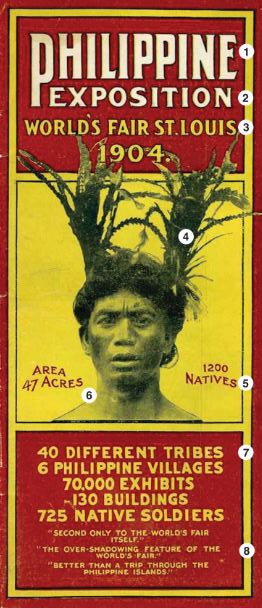
 Let us spend a little of our precious time now on mind-traveling back 115 years.
Let us spend a little of our precious time now on mind-traveling back 115 years.
The year is 1904. The time when 1,200 conquered people and 70,000 pieces of objects from the Philippines were taken by the new colonizer to their homeland, the United States of America, for a monumental exhibition.
They are all displayed in the “Philippine Pavilion” in St. Louis, Missouri. You hear and read about it in the news and in the booklet you are holding. The cover does not fail to capture your attention. It says, “PHILIPPINE EXPOSITION. WORLD’S FAIR ST. LOUIS. 1904” with an image of a familiar face which you may have not seen before printed in what looks like a small commercial poster.
The face on the cover is a person who is supposed to be your fellowman. Your own skin, so to speak. But the signs say otherwise, as the words, “native” and “tribe” are printed in warped and bold type – signifying that he may not be “you.” I cannot help thinking that the cover’s objective for the designer might have been: let the viewer gaze into this primitive man. His skin is rendered in black ink, printed over dried yellow-inked paper. This is a graphic printing technique that makes black look darker. A perfect un-fair treatment in the land of fair skin.
Welcome to the “World’s Fair!”
Forward to the present: the Missouri Digital Heritage’s website describes the “World’s Fair” as follows: “The Louisiana Purchase Exposition, commonly known as the Saint Louis World’s Fair of 1904, was the last great international exposition before World War I. The fair, built on a 1,200 acre site, included hundreds of thousands of objects, people, animals, displays, and publications from 62 exhibiting countries and 43 of the 45 states.”
The grand exposition eventually attracted academic critiques and essays published by intellectuals from different disciplines. Some of which are accessible online.
Thoughts of the St. Louis 1904 criticism came to mind after complaints and rants were posted by some of my friends on Facebook with regard to one of the Kadayawan events, the Indak Indak 2019. I also posted my punch lines, from a designer’s perspective. This is where I found Almah Bernardino-Bautista, a tourism industry consultant, as passionate about the matter as I was (and still am), based on our FB posts and comments. She happens to be my friend, so our discussions continued in our private chat. Yesterday, Almah and I agreed on sharing our thoughts on the Kadayawan issue here (Mindanao Times) in the context of the World’s Fair St. Louis 1904 booklet cover. As a designer, I find it interesting to see ideas behind the cover as fairly the same as in the way the current “cultural” events are marketed. On the other hand, Almah may see it with totally different eyes, mind and heart. Or maybe, we feel the same way.
What do the text and visual signify to her? Here are her corresponding thoughts on some of the cover’s elements:
1. PHILIPPINE: “Honestly, this is not easy for me because I have Kadayawan in mind. The main purpose of the people behind the 1904 Fair may be different from the purpose of our Kadayawan festivities.”
2. EXPOSITION: “Maybe they wanted to emphasize that this was the result of all the research they have done in the country.”
3. FAIR: “Stating the obvious that it is a fair which features different countries but somehow, a question popped into my mind… World is Fair?”
4. MAN: “I can’t say much because I don’t really know which “tribe” he represents. See? I can’t even say ‘tribe’ without using ” ” (quotation marks).”
5. NATIVES: “Same goes for “natives.” We can always change the terms that we use to show respect. But do we really show real respect or is just lip service.”
6. 47 ACRES: “The big space is like a consolation prize for the people.”
7. TRIBES: “For the organizers to identify and bring 40 “tribes” is a feat in itself. No comment on the use of the word since this was in the early 1900s.”
8. CLAIMS: “That’s promotion, can’t do anything about their choice of words.”
As we enter the last week of the Kadayawan Festival, we are given a few more days and space to not only celebrate physically, but also to satisfy a cerebral hunger for more knowledge of our land, our culture, ourselves.
And that’s fair enough!
About the contributor
Marion Descallar is a Davao-based communication designer for more than half her life now. Her views do not necessarily reflect those of Tabula Rasa’s.

